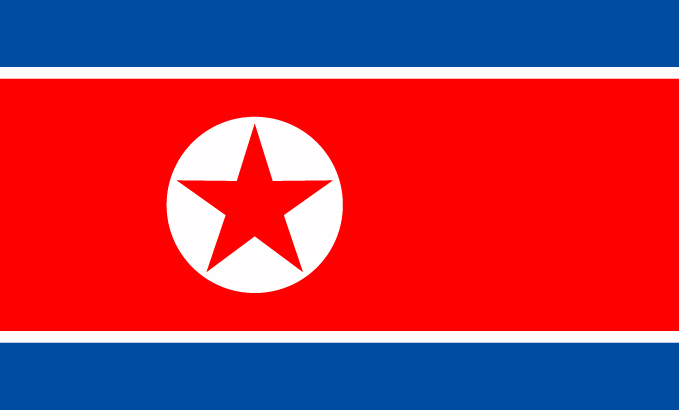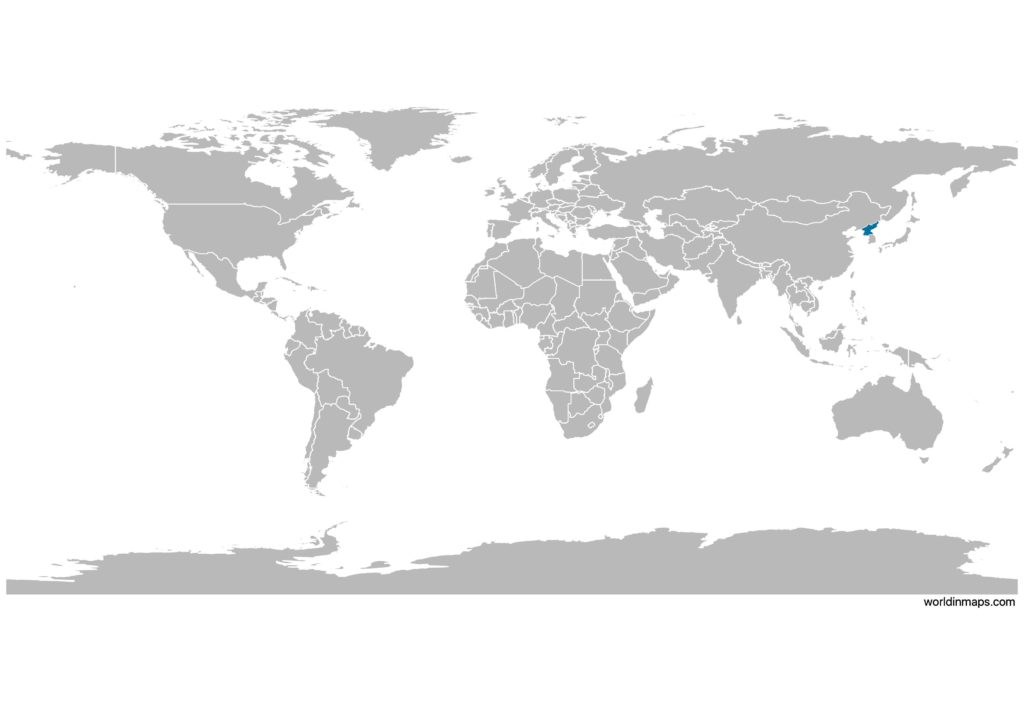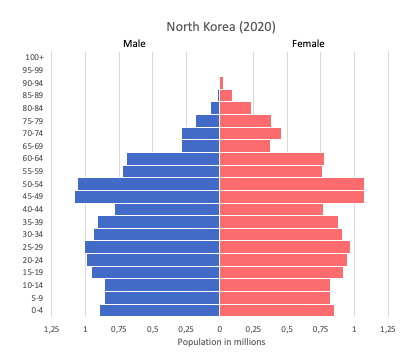North Korea

| Government | |
| Name | Democratic People’s Republic of Korea |
| Korean | 조선민주주의인민공화국 Chosŏn Minjujuŭi Inmin Konghwaguk |
| Government type | dictatorship – single-party state |
| Capital | Pyongyang(3,255,288 (2008)) |
| Currency | Korean People’s won (KPW) |
| People | |
| Population (2020) | 25,778,815 (55th) |
| Density of population | 212 P/km2 (65th) |
| Nationality | Korean |
| Official languages | |
| Korean | |
| Ethnic groups | |
| racially homogeneous (only small Chinese community and a few ethnic Japanese) | |
| Religions | |
| traditionally Buddhist and Confucianist, some Christian and syncretic Chondogyo (Religion of the Heavenly Way) note: autonomous religious activities now almost nonexistent; government-sponsored religious groups exist to provide illusion of religious freedom | |
| Life expectancy (2020) | |
| Male | 67.7 years |
| Female | 75.6 years |
| Total population | 71.6 years (161st) |
| Homicides | |
| n.a. | |
| Geography | |
| Land area | 120,408 km2 |
| water area | 130 km2 |
| total area | 120,538 km2 (100th) |
| Mean elevation | 600 m |
| Lowest point | |
| Sea of Japan | 0 m |
| Highest point | |
| Paektu-san | 2,744 m |
| Land use (2011) | |
| Agricultural land | 21.8% |
| Arable land | 19.5% |
| Permanent crops | 1.9% |
| Permanent pasture | 0.4% |
| Forest | 46% |
| Other | 32.2% |
| Urbanization | |
| Urban population (2020) | 62.4% |
| Rate of urbanization | 0.82% annual rate of change (2015 – 2020) |
| Economy | |
| Labor force (2014) | 14 million (41st) |
| Labor force by occupation (2008) | |
| Agriculture | 37% |
| Industry and services | 63% |
| Unemployment rate (2013) | 25.6% (197th) |
| GDP (PPP) (estimate 2014) | |
| Total | $40 billion |
| Per capita | $1,800 |
| GDP (nominal) (estimate 2017) | |
| Total | $30 billion |
| Per capita | $1,300 |
| GDP by sector (estimate 2017) | |
| Agriculture | 22.5% |
| Industry | 47.6% |
| Services | 29.9% |
| Exports (2017) | $4.582 billion |
| Exports partners (2017) | |
| China | 86.3% |
| Imports (2018) | $2.32 billion (160th) |
| Imports partners (2017) | |
| China | 91.9% |
North Korea on the world map

North Korea top 10 largest cities (2008)
- Pyongyang (3,255,288)
- Hamhung (768,551)
- Chongjin (667,929)
- Nampo (366,815)
- Wonsan (363,127)
- Sinuiju (359,341)
- Tanchon (345,875)
- Kaechon (319,554)
- Kaesong (308,440)
- Sariwon (307,764)
Demography
Population pyramid

Age structure data
Estimate for 2020:
- 0-14 years: 20.47% (male 2,677,578/female 2,571,118)
- 15-24 years: 14.68% (male 1,894,091/female 1,869,799)
- 25-54 years: 44% (male 5,659,446/female 5,624,034)
- 55-64 years: 11.2% (male 1,369,199/female 1,503,086)
- 65 years and over: 9.65% (male 859,151/female 1,615,964)
Remark: the age structure of a population affects a nation’s key socioeconomic issues. Countries with young populations (high percentage under age 15) need to invest more in schools, while countries with older populations (high percentage ages 65 and over) need to invest more in the health sector. The age structure can also be used to help predict potential political issues. For example, the rapid growth of a young adult population unable to find employment can lead to unrest.
Population from 1950 to 2020
Source: United Nations, Department of Economic and Social Affairs, Population Division (2019). World Population Prospects 2019, Online Edition. Rev. 1.
Evolution of the life expectancy from 1960 to 2018
Source: World Development Indicators, The World Bank
Economy
Agriculture:
rice, corn, potatoes, wheat, soybeans, pulses, beef, pork, eggs, fruit, nuts
Industries:
military products; machine building, electric power, chemicals; mining (coal, iron ore, limestone, magnesite, graphite, copper, zinc, lead, and precious metals), metallurgy; textiles, food processing; tourism
Exports – commodities:
minerals, metallurgical products, manufactures (including armaments), textiles, agricultural and fishery products
Imports – commodities:
petroleum, coking coal, machinery and equipment, textiles, grain
Time zone and current time in North Korea
Go to our interactive map to get the current time in North Korea